spare tire AUDI Q5 2015 Owners Manual
[x] Cancel search | Manufacturer: AUDI, Model Year: 2015, Model line: Q5, Model: AUDI Q5 2015Pages: 302, PDF Size: 75.01 MB
Page 5 of 302
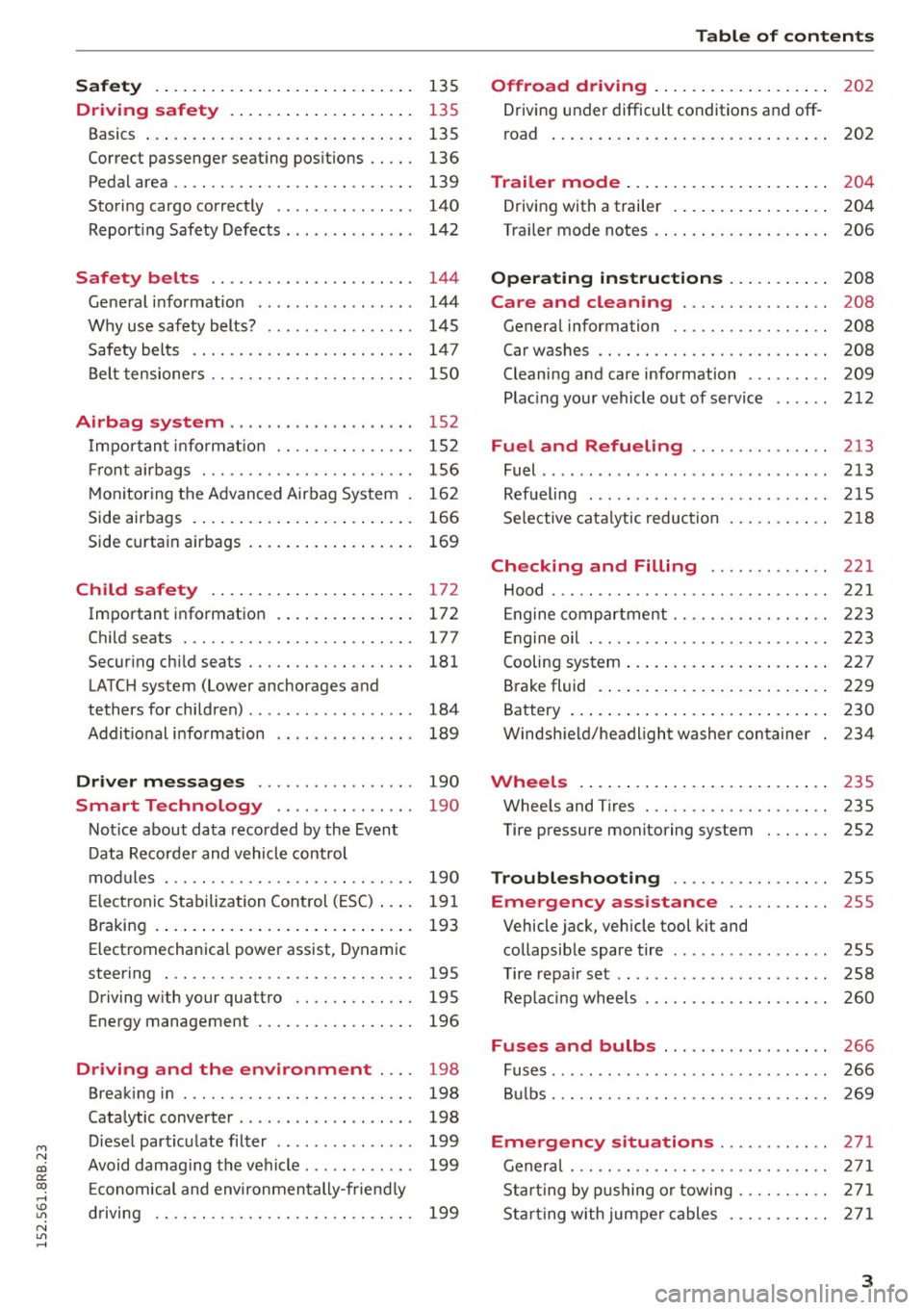
M N
co
a:
co
,...., \!) 1.1'1
N 1.1'1 ,....,
Safety . . . . . . . . . . . . . . . . . . . . . . . . . . . . 135
Driving safety . . . . . . . . . . . . . . . . . . . . 135
Basics . . . . . . . . . . . . . . . . . . . . . . . . . . . . . 135
Correct passenger seat ing positions . . . . . 136
Pedal area . . . . . . . . . . . . . . . . . . . . . . . . . . 139
Storing cargo correct ly . . . . . . . . . . . . . . . 140
Reporting Safety Defects . . . . . . . . . . . . . . 142
Safety belts . . . . . . . . . . . . . . . . . . . . . . 144
General information . . . . . . . . . . . . . . . . . 144
Why use safety belts? . . . . . . . . . . . . . . . . 145
Safety belts . . . . . . . . . . . . . . . . . . . . . . . . 147
Belt tensioners . . . . . . . . . . . . . . . . . . . . . . 150
Airbag system . . . . . . . . . . . . . . . . . . . . 152
Important information . . . . . . . . . . . . . . . 152
Front airbags . . . . . . . . . . . . . . . . . . . . . . . 156
Monito ring the Advanced Airbag System . 162
Side airbags . . . . . . . . . . . . . . . . . . . . . . . . 166
Side curtain airbags . . . . . . . . . . . . . . . . . . 169
Child safety . . . . . . . . . . . . . . . . . . . . . . 172
Important information . . . . . . . . . . . . . . . 172
Child seats .............. .... .. .. ... 177
Secur ing ch ild seats . . . . . . . . . . . . . . . . . . 181
LATCH system (Lower anchorages and
tethers for children) . . . . . . . . . . . . . . . . . . 184
Addit ional info rmation . . . . . . . . . . . . . . . 189
Driver messages . . . . . . . . . . . . . . . . . 190
Smart Technology . . . . . . . . . . . . . . . 190
Notice about data recorded by the Event
Data Recorder and vehicle control
modules . . . . . . . . . . . . . . . . . . . . . . . . . . . 190
E lect ronic Stabilization Control (ESC) . . . . 191
B raking . . . . . . . . . . . . . . . . . . . . . . . . . . . . 193
Electromechanica l power assist, Dynamic
steering . . . . . . . . . . . . . . . . . . . . . . . . . . . 195
Driving with your quattro . . . . . . . . . . . . . 195
Energy management . . . . . . . . . . . . . . . . . 196
Driving and the environment . . . . 198
Breaking in . . . . . . . . . . . . . . . . . . . . . . . . . 198
Cata lytic converter . . . . . . . . . . . . . . . . . . . 198
Diesel particu late filter . . . . . . . . . . . . . . . 199
Avoid damaging the vehicle . . . . . . . . . . . . 199
Econom ical and environmentally-friend ly
driving . . . . . . . . . . . . . . . . . . . . . . . . . . . . 199
Table of contents
Offroad driving . . . . . . . . . . . . . . . . . . .
202
Driving under difficult conditions and off-
road . . . . . . . . . . . . . . . . . . . . . . . . . . . . . . 202
Trailer mode . . . . . . . . . . . . . . . . . . . . . . 204
Driving with a trailer . . . . . . . . . . . . . . . . . 204
Tra iler mode notes . . . . . . . . . . . . . . . . . . . 206
Operating instructions . . . . . . . . . . . 208
Care and cleaning . . . . . . . . . . . . . . . . 208
General information . . . . . . . . . . . . . . . . . 208
Car washes . . . . . . . . . . . . . . . . . . . . . . . . . 208
Cleaning and care information . . . . . . . . . 209
Placing your vehicle out of service . . . . . . 212
Fuel and Refueling .......... ... .. 213
Fuel .. ..... ... .. .. ........ ...... ... 213
Refueling ... .. .. .. ... .. ... ..... .. .. 215
Selective catalytic reduction 218
Checking and Filling . . . . . . . . . . . . . 221
Hood . . . . . . . . . . . . . . . . . . . . . . . . . . . . . . 221
Eng ine compartm ent . . . . . . . . . . . . . . . . . 223
En gine oil . . . . . . . . . . . . . . . . . . . . . . . . . . 223
Cooling system . . . . . . . . . . . . . . . . . . . . . . 227
Brake fluid . . . . . . . . . . . . . . . . . . . . . . . . . 229
Battery . . . . . . . . . . . . . . . . . . . . . . . . . . . . 230
Windshield/headlight washer container 234
Wheels .. .... .. .. ... ........ .. .. .. 235
Wheels and Tires . . . . . . . . . . . . . . . . . . . . 235
Tire pressure monitoring system . . . . . . . 252
Troubleshooting . . . . . . . . . . . . . . . . . 255
Emergency assistance . . . . . . . . . . . 255
Vehicle jack, vehicle tool kit and
collapsib le spare tire . . . . . . . . . . . . . . . . . 255
Tire repair set . . . . . . . . . . . . . . . . . . . . . . . 258
Replacing wheels . . . . . . . . . . . . . . . . . . . . 260
Fuses and bulbs . . . . . . . . . . . . . . . . . . 266
Fuses. ...... .. .. .. ... .. ... ..... .. .. 266
Bulbs. . . . . . . . . . . . . . . . . . . . . . . . . . . . . . 269
Emergency situations . . . . . . . . . . . . 271
General . . . . . . . . . . . . . . . . . . . . . . . . . . . . 271
Starting by pushing or towing . . . . . . . . . . 271
Starting with jumper cables . . . . . . . . . . . 27 1
3
Page 79 of 302
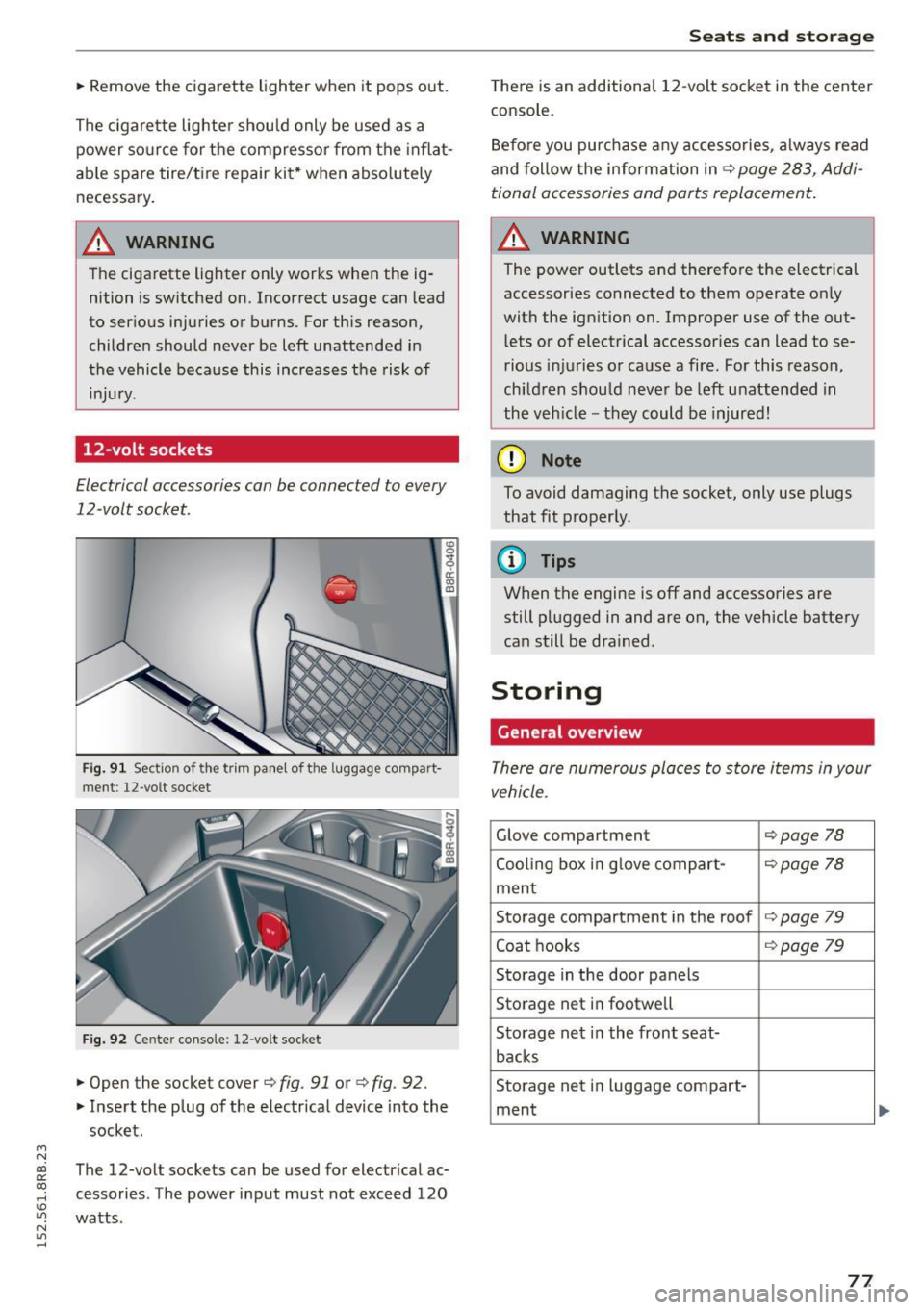
M N
co ~ co
rl I.O
"' N
"' rl
.. Remove the cigarette lighter when it pops out.
The c igarette lighter should only be used as a
power source for the compressor from the i nflat
able spare tire/tire repair kit* when absolutely
necessary.
A WARNING
The cigarette lighter only works when the ig
nition is switched on. Incorrect usage can lead
to serious injuries or burns. For this reason,
children should never be left unattended in
the vehicle because this increases the risk of
injury .
12-volt sockets
Electrical accessories can be connected to every
12-volt socket.
Fig . 91 Sect io n of the trim panel of t he luggage com part·
ment : 12-vo lt socket
Fig. 92 Ce nter console: 12-volt socket
.. Open the socket cover¢ fig. 91 or¢ fig. 92.
.. Insert the plug of the electrical device into the
socket.
The 12-volt sockets can be used for electrical ac
cessories . The power input must not exceed 120
watts .
Seats and storage
There is an additional 12 -volt socket in the center
console .
Before you purchase any accessories, always read
and follow the information in¢
page 283, Addi
tional accessories and parts replacement.
A WARNING
The power outlets and therefore the electrical
accessories connected to them operate only
with the ignition on . Improper use of the out
lets or of electrical accessories can lead to se
rious injuries or cause a fire . For this reason,
children should never be left unattended in
the veh icle -they could be injured!
(D Note
To avoid damaging the socket, only use plugs
that fit properly.
(D Tips
When the engine is off and accessories are
still plugged in and are on, the vehicle battery
can still be drained .
Storing
General overview
There are numerous places to store items in your
vehicle .
Glove compartment ¢page 78
Cooling box in glove compart-¢page 78
ment
Storage compartment in the roof
¢page 79
Coat hooks ¢page 79
Storage in the door panels
Storage net in footwell
Storage net in the front seat- backs
Storage net in luggage com part- ment
77
Page 244 of 302
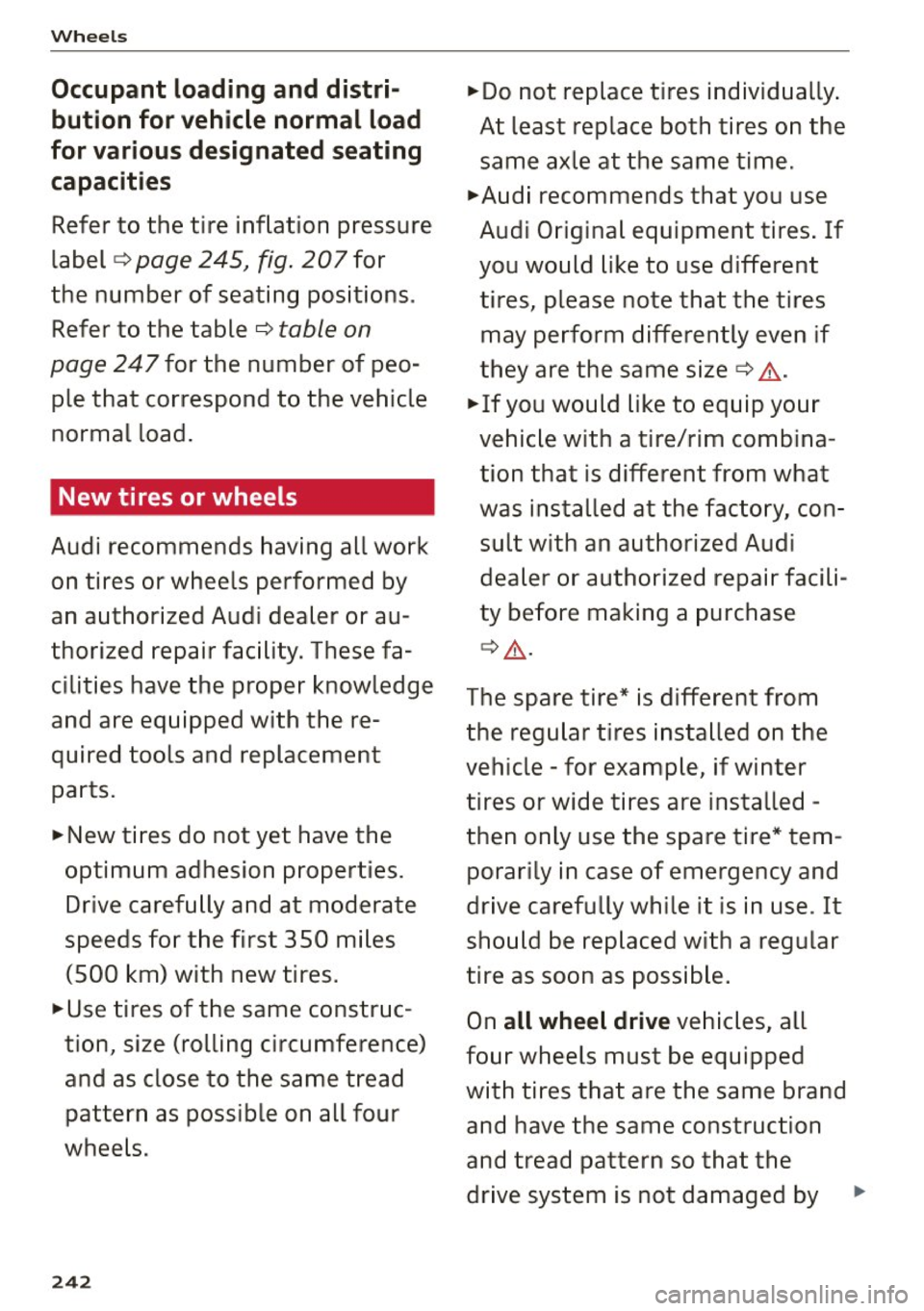
Wheels
Occupant loading and distri
bution for veh icle normal load
for various designated seat ing
capacit ies
Refer to the tire inflation pressure
label
c:> page 245, fig . 207 for
the number of seating positions .
Refer to the table
c:> table on
page
247for the number of peo
ple that correspond to the vehicle
normal load .
New tires or wheels
Audi recommends having all wo rk
on tires or wheels performed by
an authorized Audi dea ler or au
thorized repair fac ility. These fa
cilities have the proper knowledge
and are equipped with the re
quired tools and replacement
parts.
.,. New tires do not yet have the
optimum adhesion properties. Drive carefully and at moderate
speeds fo r the first 350 miles
(500 km) with new tires .
.,. Use tires of t he same constr uc
tion, size (rolling c ircumference)
and as close to the same tread pattern as possible on all four
wheels.
2 4 2
.,.Do not replace tires individ ually .
At least re place both t ires on the
same axle at the same time.
.,. A udi recommends that you use
Aud i O riginal equipment tires . If
you wo uld li ke to use different
tires, please note that the tires may perform d ifferently even if
they are the same s ize
c:> &. -
.,. If you would like to equip you r
vehic le with a tire/rim combina
tion that is different from what
was installed at the facto ry, con
sult w ith an authorized Aud i
dealer or authorized repair facili
ty be fore making a purchase
¢ .&_ .
The spare tire* is d ifferent from
the regular t ires installed on the
vehicle -for example, if winter
tires or wi de tires are installed -
then only use the spare tire* tem
porar ily in case of emergency and
drive carefully while it is in use . It
s h o u ld be replaced w ith a regular
tire as soon as poss ib le.
On
all wheel drive ve hic les, all
four wheels must be equipped
w ith tires that are the same brand
and have the same construction
and tread pattern so that the
drive system is not damaged by
Page 245 of 302
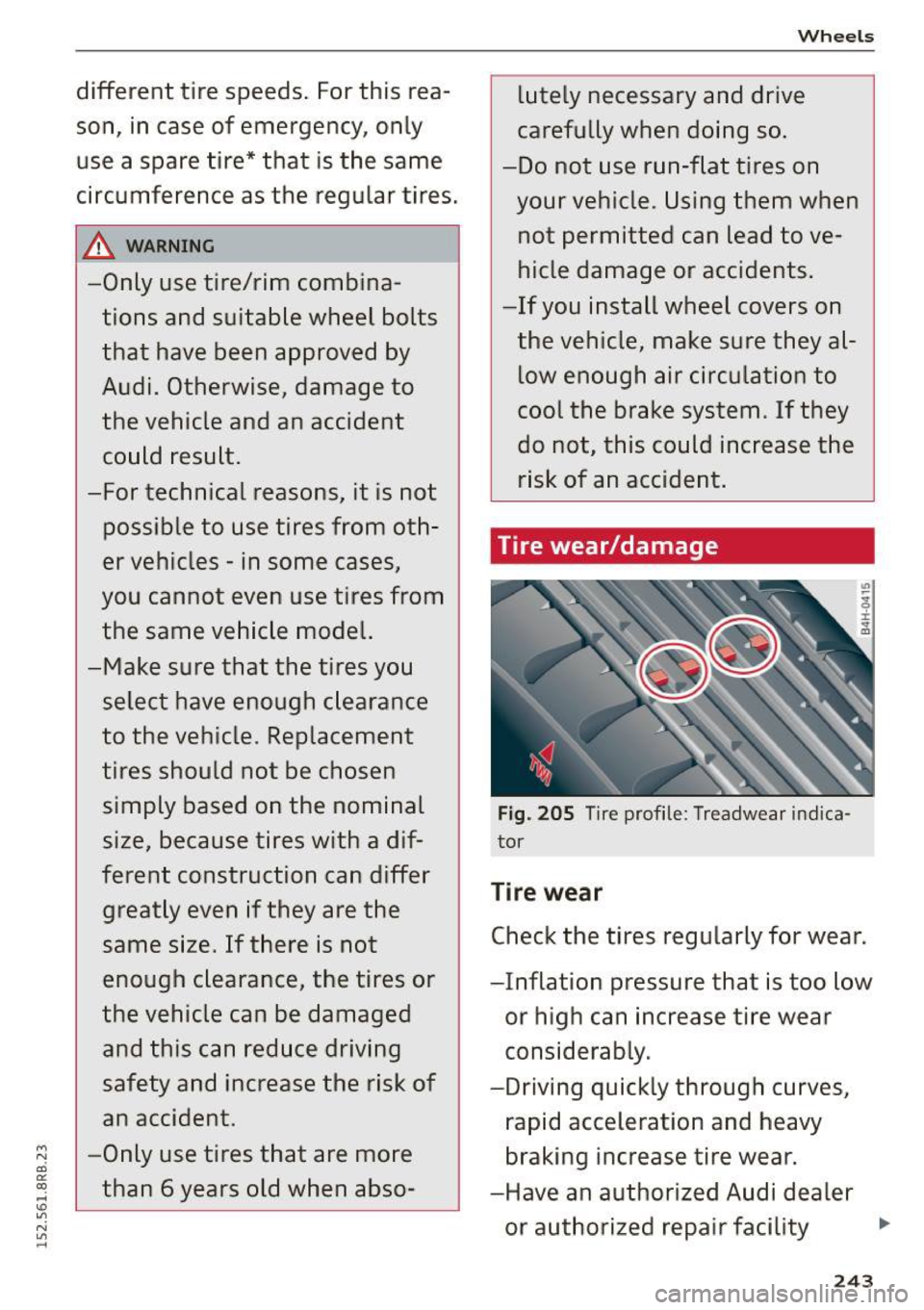
M N ai
"' ~
-"' "' N
"' .....
different tire speeds. For this rea
son, in case of emergency, only
use a spare tire* that is the same
circumference as the regular tires.
A WARNING -
-Only use tire/rim combina
tions and suitable wheel bolts
that have been approved by
Audi. Otherwise, damage to
the vehicle and an accident
could result.
-For technical reasons, it is not possible to use tires from oth
er vehicles - in some cases,
you cannot even use tires from
the same vehicle model.
-Make sure that the tires you select have enough clearance
to the vehicle . Replacement
tires should not be chosen
simply based on the nominal
size, because tires with a dif
ferent construction can differ greatly even if they are the
same size. If there is not
enough clearance, the tires or
the vehicle can be damaged
and this can reduce driving
safety and increase the risk of
an accident.
-Only use tires that are more
than 6 years old when abso-
Wheels
lutely necessary and drive
carefully when doing so.
-Do not use run-flat tires on your vehicle . Using them when
not permitted can lead to ve
hicle damage or accidents.
-If you install wheel covers on
the vehicle, make sure they al low enough air circulation to
cool the brake system. If they
do not, this could increase the
risk of an accident.
Tire wear/damage
Fig. 205 Tir e profi le : Treadwear indica
tor
Tire wear
Check the tires regularly for wear.
-Inflation pressure that is too low
or high can increase tire wear
considerably .
-Driving quickly through curves,
rapid acceleration and heavy
braking increase tire wear.
-Have an authorized Audi dealer or authorized repair facility
243
...
Page 247 of 302
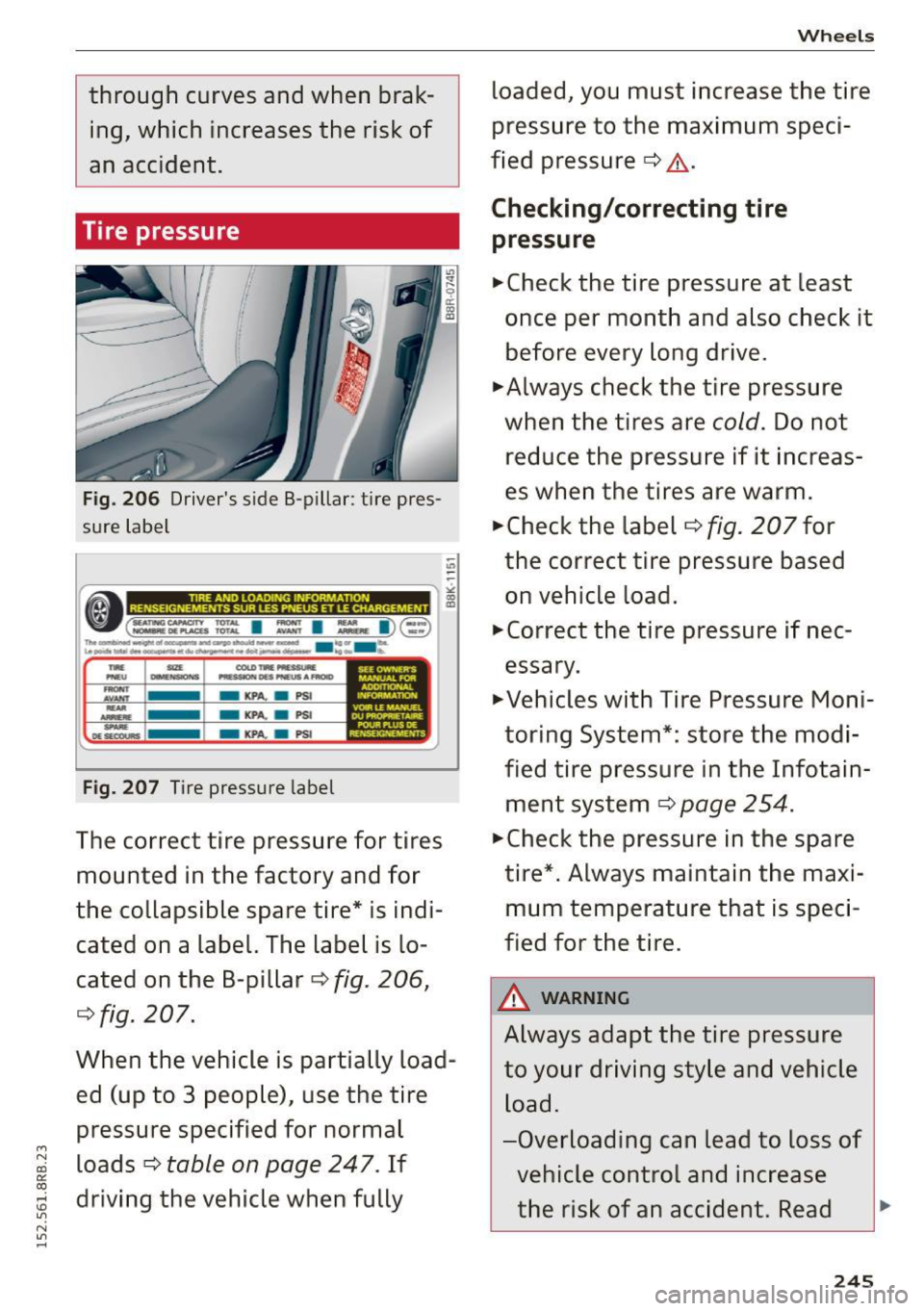
M
through curves and when braking, which increases the risk of
an accident.
Tire pressure
Fig. 206 Driver's side B-pillar : tire pres
sure label
"' -
-~-----------------,£
tM£. IIZl COLO tlllf fllllESSt.lW. PNfU Nl:4fN$IOM$ "IIISaoN OE$ PMEU$ A FROID
-AYIJff -KPA. a PSI
.::. -KPA.
a PSI
Fig. 207 Tire pressure label
The correct tire pressure for tires
mounted in the factory and for
the collapsible spare tire* is indi
cated on a label. The label is lo
cated on the B-pillar ¢
fig. 206,
¢ fig. 207.
When the vehicle is partially load ed (up to 3 people), use the tire
pressure specified for normal
~ loads¢ table on page 247. If 0::
; driving the vehicle when fully V
"' V ...;
Wheels
Loaded, you must increase the tire
pressure to the maximum speci
fied pressure¢ ,&.
Checking/correcting tire
pressure
.,..Check the tire pressure at least
once per month and also check it before every long drive .
.,..Always check the tire pressure
when the tires are
cold. Do not
reduce the pressure if it increas
es when the tires are warm.
.,..Check the label ¢
fig. 207 for
the correct tire pressure based on vehicle load.
.,..Correct the tire pressure if nec
essary.
.,..Vehicles with Tire Pressure Moni
toring System*: store the modi
fied tire pressure in the Infotain ment system¢
page 254 .
.,..Check the pressure in the spare
tire*. Always maintain the maxi mum temperature that is speci
fied for the tire .
_& WARNING
Always adapt the tire pressure
to your driving style and vehicle
load.
-Overloading can lead to loss of vehicle control and increase
the risk of an accident. Read
245
Page 254 of 302

Wheels
Quality grades can be found where applicable on
the tire side wall between t read sho ulder and
maximum sect ion w idth
c::> page 235, fig . 204.
For example: Tr ead wear 200 , Tract ion AA, Tem
peratu re
A .
All passenger ca r tires must confo rm to Federal
Safety Req uiremen ts in add it ion to these grades.
Tread wear
The tread wear grade is a comparative rating
based on the wear rate of the tire when tested
unde r controlled conditions on a spec ified gov
ernment test course.
For examp le, a t ire graded 150 would wear one
and one half ( 1 1/2) t imes as well on the govern
ment course as a tire graded 100 .
The relat ive performance of t ires depends upon
the actua l conditions of their use, however, and
may depart significantly from the norm due to
variations i n driving hab its, service practices and
d iffe rences in road character istics and clima te.
Traction
The traction grades, from highest to lowest, are
AA, A , Band
C. Those grades represent the tire's
ab ility to stop on wet pavement as measu red u n
de r controlled cond it ions on spec ified govern
ment test su rfaces of asphalt and concrete. A tire
marked C may have poor traction performance
c::> &_ .
Temperature
The temperature grades are A (the highest), B,
a nd C, rep resent ing t he tire's res istance to the
genera tion of heat and its a bility to dis sipate
heat w hen tested unde r controlled cond itions on
a specified indoo r laboratory test whee l.
Sustained high temperature can cause the mate rial of the tire to degenerate and red uce tire life,
a nd excessive tempera ture can lead to sudden
tire failure
c::> &. .
The grade C co rresponds to a level of perform
ance wh ich a ll passenge r ca r tires m ust meet un
de r th e Federal Motor Vehicle Safety S tandard
No. 109. G rades Band A represent higher levels
252
of pe rformance on the laboratory test whee l than
the minimum required by law .
A WARNING -
The traction grade assigned to th is tire is
based on straight-ahead braking tract ion
tests, and does not include acce lerat ion, cor
nering, hyd roplaning or peak traction charac
teristics.
A WARNING
The temperature g rade for th is tire is estab
lished for a tire that is properly inf lated and
n ot ove rloaded. Excess ive speed, underi nfla
tion, o r ex cess ive lo adi ng, eithe r separately or
i n comb inat io n, can ca use heat bu ild up and
possible tire failure.
A WARNING
Tempe ratu re grades apply to ti res that are
properly inflated and not over or underinflat
ed.
Tire pressure monitoring system
(l) General notes
App lies to vehicl es: wi th tire p ress ure mo nito rin g system
-
Each tire, incl uding the spare (if provided),
sho uld be checked monthly when co ld and inflat
ed to the inflat ion pressure recommended by the
vehicle manufacturer on the vehicle placard or
tire inflat ion pressure label. (If your vehicle has
tires of a different s ize than the size indicated on
the ve hicle placard or t ire inflation pressu re la
bel, you should dete rm ine the p roper t ire infla
tion pressu re for those t ires).
As a n added safety feature, your ve hicle has been
equipped with a tire pressure mon itor ing system
( TP MS) that illum inates a low t ire pressure te ll-
ta le w hen o ne or mo re of yo ur ti res is sign ificant -
l y unde r-i nflated. According ly, w hen t he low t ire
pressure te lltale illuminates, you shou ld stop and
check yo ur tires as soon as possible, and inflate
them to the proper pressure . Dr iving on a signifi
cant ly under-inf lated tire causes the t ire to over
heat and can lead to tire failure. Under-inflation .,,.
Page 255 of 302

M N
co
a:
co
,...., \!) ..,.,
N ..,., ,....,
also reduces fuel efficiency and tire tread life,
and may affect the vehicle's handling and stop
ping ability .
Please note that the TPMS is not a substitute for
proper tire maintenance, and it is the driver's re
sponsibility to maintain correct tire pressure,
even if under-inflation has not reached the level
to trigger illumination of the TPMS low tire pres
sure telltale.
Your vehicle has also been equipped with a TPMS malfunction indicator to indicate when the sys
tem is not operating properly. The TPMS mal
function indicator is combined with the low tire pressure telltale . When the system detects a
malfunct ion, the telltale will flash for approxi
mately one minute and then remain continuously
illuminated. This sequence will continue upon
subsequent veh icle start-ups as long as the mal
function exists.
When the malfunction indicator is illuminated,
the system may not be able to detect or signal
low tire pressure as intended. TPMS malfunctions
may occur for a variety of reasons, including the
installation of replacement or alternate tires or
wheels on the vehicle that prevent the TPMS
from functioning properly. Always check the
TPMS malfunction telltale after replacing one or more tires or wheels on your vehicle to ensure
that the replacement or alternate tires and
wheels allow the TPMS to continue to function properly.
Wheels
If the Tire Pressure Monitoring System
indicator appears
Appl ies to vehicles : wi th t ir e p ress ure mo nito rin g system
The tire pressure indicator in the instrument
cluster informs you if the tire pressure is too low
or if there is a system malfunction.
Fig. 208 Instrument cluster: i ndicator light with message
Using the ABS sensors, the tire pressure monitor
ing system compares the tire tread circumference
and vibration characteristics of the individual
tires .
If the pressure changes in one or more
tires, this is indicated in the instrument cluster
display with an indicator light
RIJ and a message
¢fig. 208. If only one tire is affected, the loca
tion of that tire will be indicated.
The tire pressures must be stored in the Infotain
ment system again each time the pressures
change (switching between partial and full load
pressure) or after changing or replacing a tire on
your vehicle ¢
page 254. The tire pressure moni
toring system only monitors the tire pressure you have stored. Refer to the tire pressure label for
the recommended tire pressure for your vehicle
¢ page 245, fig . 207.
Tire tread circumference and vibration character
istics can change and cause a tire pressure warn
ing if:
- the tire pressure in one or more tires is too low .
- the tire has structural damage.
- the tir e was replaced or the tire pressure
changed and it was not stored again
c:!;> page 254.
-the collapsible spare* tire is installed.
253
Page 257 of 302
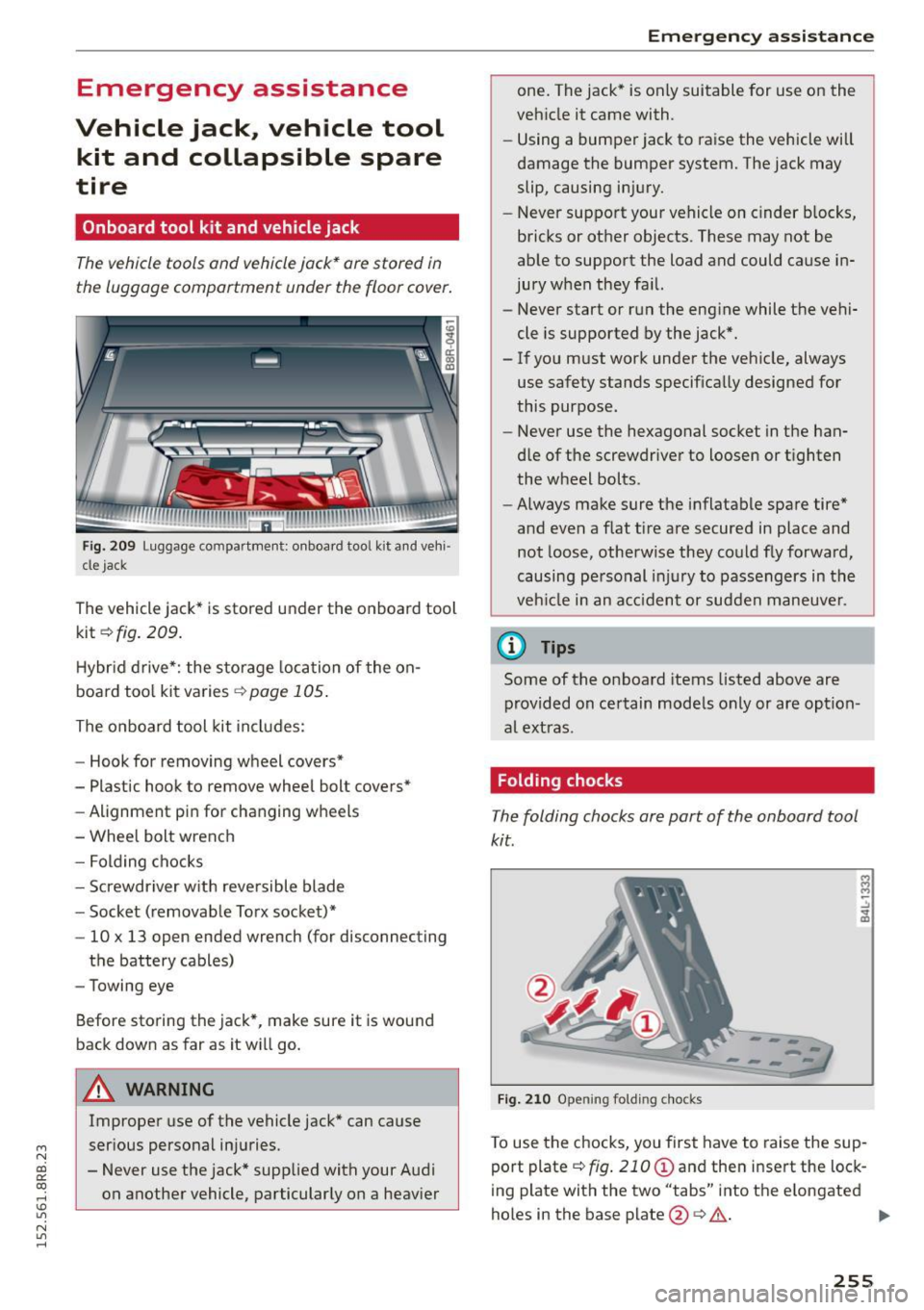
M N
co ~ co
rl I.O
"' N
"' rl
Emergency assistance
Vehicle jack, vehicle tool kit and collapsible spare
tire
Onboard tool kit and vehicle jack
The vehicle tools ond vehicle jack* are stored in
the luggage compartment under the floor cover.
Fig. 209 Luggage compartme nt: on board tool kit and vehi·
cle jack
The vehicle jack* is stored under the on board tool
ki t¢ fig.
209.
Hybrid drive*: the storage location of the on
board too l kit varies ¢
page 105.
The on board tool kit includes:
- Hook for removing wheel covers*
- Plastic hook to remove wheel bolt covers*
- Alignment p in for cha nging wheels
- Wheel bolt wrench
- Folding chocks
- Screwdriver w ith reversible blade
- Socket (removable Torx socket)*
- 10 x 13 open ended wrench (for disconnecting
the battery cables)
- Towing eye
Befo re storing the jack*, make sure it is wound
back down as far as it will go.
A WARNING
Improper use of the vehicle jack* can cause
ser ious personal injuries.
- Never use the jack* supplied with your Audi
on another vehicle, particularly on a heav ier
-
Emergen cy assistance
one. The jack * is only suitable for use on the
veh icle it came with.
- Using a bumper jack to raise the vehicle will
damage the bumper system. The jack may
slip, causing injury.
- Never support your vehicle on c inder b locks,
bricks or other objects. These may not be
able to support the load and could cause in·
jury when they fa il.
- Never start or run the engine while the vehi
cle is supported by the jack*.
- If you must work under the vehicle, always
use safety stands specifically designed for
this purpose.
- Never use the hexagonal socket in the han
dle of the screwdriver to loosen or tighten
the wheel bolts.
- Always make sure the inflatable spare tire*
and even a flat tire are secured in place and
not loose, otherwise they could fly forward,
causing personal injury to passengers in the
veh icle in an acc ident or sudden maneuver.
(D Tips
Some of the on board items listed above are
provided on certain models only or are option
al extras.
Folding chocks
The folding chocks are part of the on board tool
kit.
--.. ,..
Fig. 210 Open ing foldi ng chock s
To use the chocks, you first have to rais e the sup ·
port plate r::!,>
fig. 210 (!) and then i nsert the lock
ing plate with the two "tabs" into the e longated
holes in the base pl ate@¢
A. .,.
255
Page 258 of 302
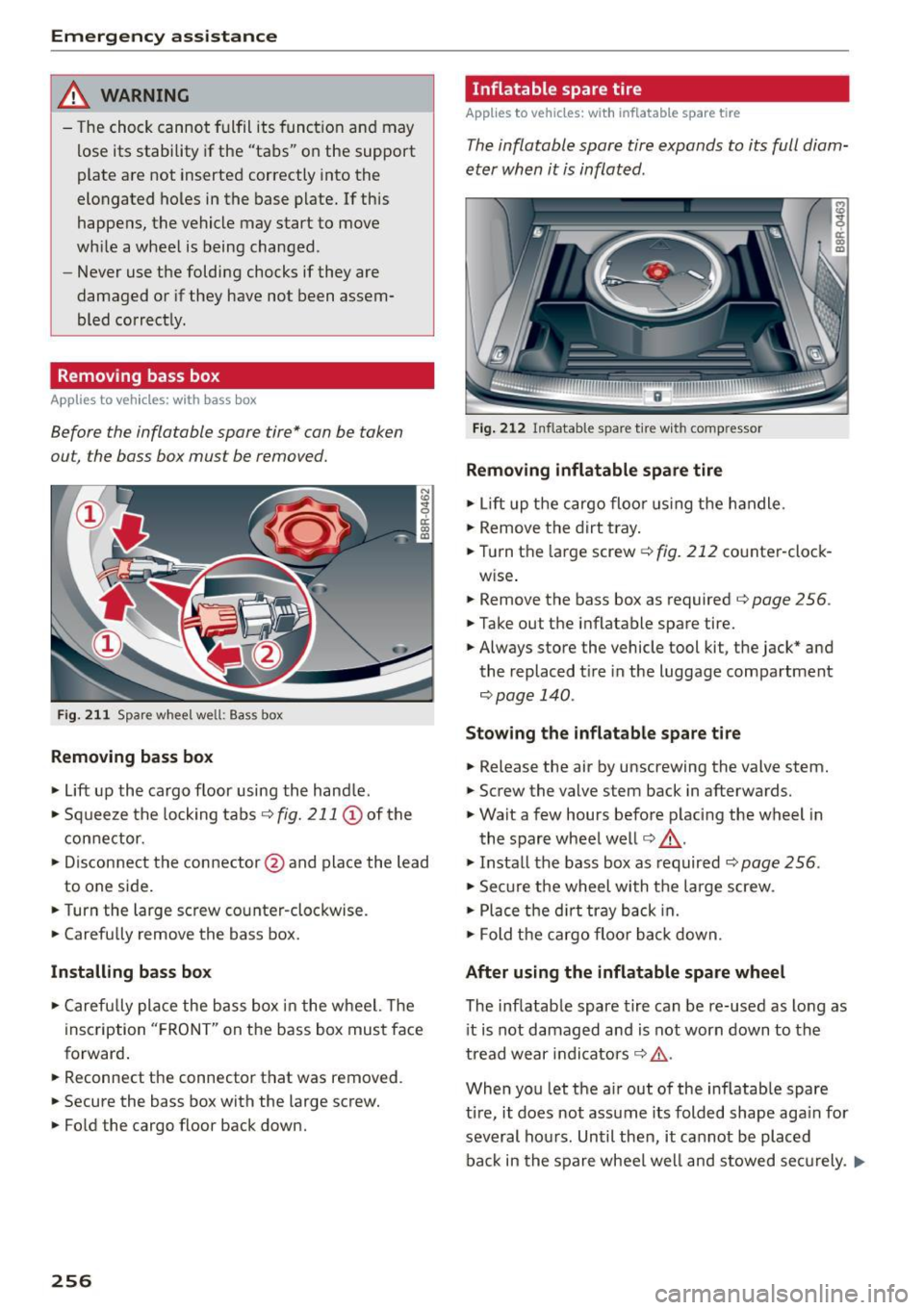
Emergency assistance
_& WARNING
- The chock cannot fulfil its funct io n and may
lose its stability if the "tabs" on the support
plate are not inserted correctly into the
elongated holes in the base plate. If th is
happens, the vehicle may start to
move
wh ile a wheel is being changed .
- Never use the folding chocks if they are
damaged o r if they have not been assem
bled correct ly.
Removing bass box
Applies to veh icles: w ith bass box
Before the inflatable spare tire* can be taken
ou t, the bass box must be removed.
F ig . 211 Spare whee l well: Ba ss box
Removing bass box
" Lift up the cargo floor using the hand le .
" Squ eeze the lock ing tabs
q fig. 211 (D of the
con nector.
" Disconne ct the connector @and place the lead
to one side .
"T urn the large screw co unter -clockwise.
" Carefu lly remove the bass box.
Installing bass box
" Carefully place the b ass box in t he wheel. The
inscription " FRON T" on the bass box mus t face
forward .
" Reconnect the connector that was removed .
" Secure the bass box with the large screw.
" Fo ld the cargo floor back down.
256
Inflatable spare tire
Applies to vehicles: with inflatable spare tire
The inflatable spare tire expands to its full diam
eter when it is inflated .
Fig. 212 In flatable spa re tir e with compressor
Removing inflatable spare tire
" Lift up the cargo floo r using t he h andle .
" Remove the dirt tray .
" Tu rn the large screw
q fig . 212 co unter -clock-
w ise .
" Remove the bass box as required
q page 256 .
"Take out the inflatable spare tire.
" Always store the vehicle tool kit, the jack* and
the replaced t ire in the luggage c ompa rtment
q page 140.
Stowing the inflatable spare tire
" Release the air by unscrewing the valve stem.
" Screw the
valve stem back in afterwards.
" Wait a few hours befo re p lacing the wheel in
the spare wheel well
9 & .
"Insta ll the bass box as required qpage 256.
" Sec ure t he wheel with the large screw .
" Place the dirt tray back in.
" Fold the cargo floo r ba ck down .
After using the inflatable spare wheel
The inflatab le spare tire can be re-used as lo ng as
i t is not damaged and is not worn down to the
tread wear indicators
q &, .
When you let the a ir out of the inf latab le spare
t ir e, it does not assume its folded shape aga in for
several hours. Until then, it ca nnot be placed
back in the spare wheel we ll and stowed se cu rely . .,.
Page 259 of 302
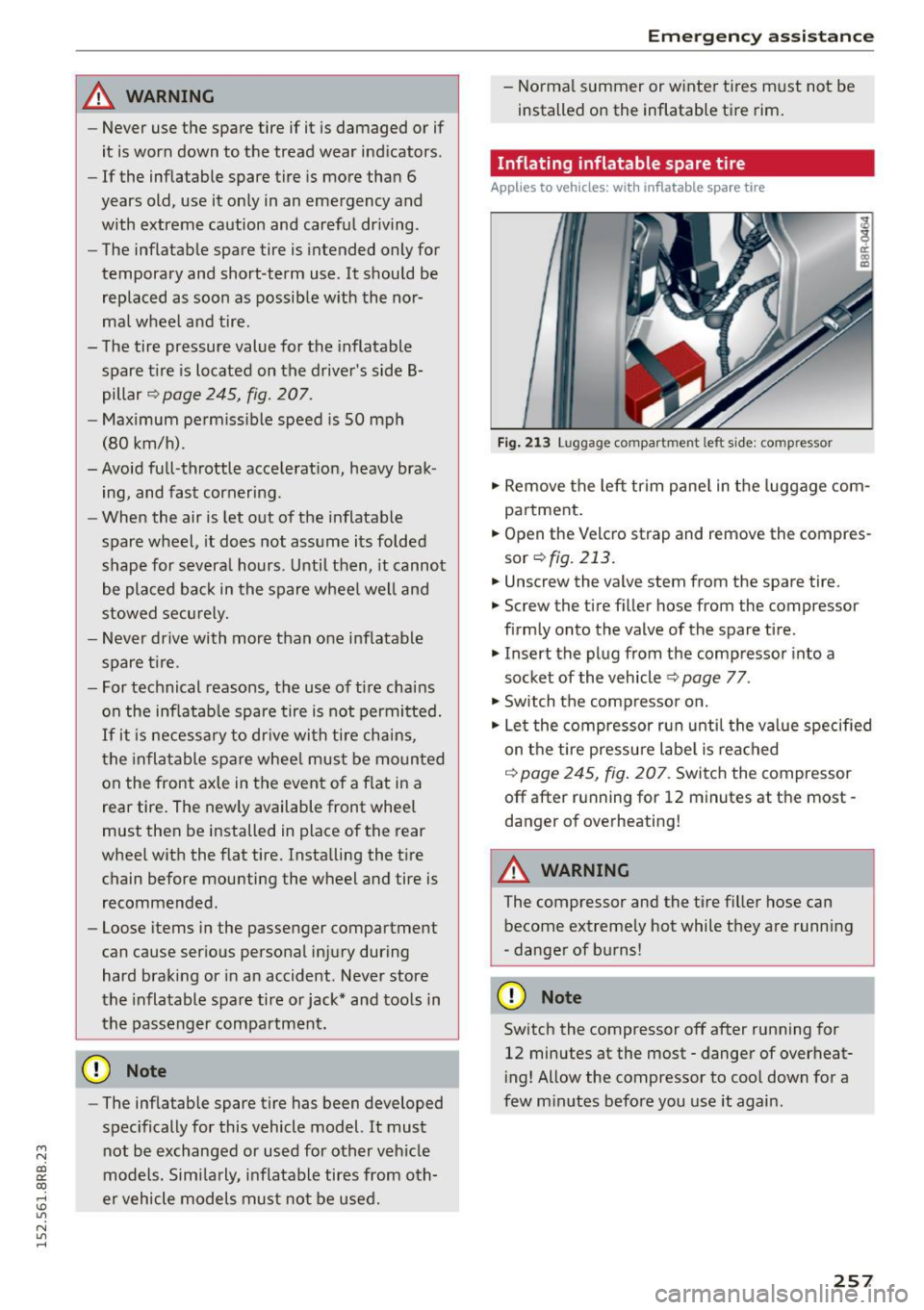
M N
co ~ co
rl I.O
"' N
"' rl
_& WARNING
-Never use the spare tire if it is damaged or if
it is worn down to the tread wear ind icators .
-If the inflatable spare tire is more than 6
years old, use it only in an emergency and
with extreme caution and careful dr iving .
- The inflatable spare tire is intended only for
temporary and short -term use . It should be
replaced as soon as possib le w ith the nor
mal wheel and tire .
- The tire pressure value for the inflatable
spare t ire is Located on the driver's side
B
pillar ¢ page 245, fig. 207 .
-Maximum pe rm issible speed is 50 mph
(80 km/h) .
-Avoid full -throttle acce lerat ion, heavy brak
ing, and fast cornering .
- When the air is let out of the inflatable
spare wheel, it does not assume its folded
shape for severa l hours . Until then, it cannot
be placed back in the spare whee l well and
stowed secu rely.
- Never drive with more than one inflatable
spare t ire.
- For technical reasons, the use of tire chains
on the inf latab le spare tire is not permitted.
If it is necessary to dr ive with tire chains,
the inflatable spare whee l must be moun ted
on the front axle in the event of a flat in a rear tire. The new ly available front wheel
must then be i nstalled in place of the rear
w heel with the flat tire. Insta lling the t ire
chain before mounting the wheel and tire is
recommended .
- Loose items in the passenger compartment
can cause ser ious personal injury during
hard braking or in an accident. Never store
the inflatable spare tire or jack* and too ls in
the passenger compa rtment.
CD Note
- The inf latable spare tire has been developed
spec ifically for this vehicle model.
It must
not be exchanged or used for other veh icle
models. Simi la rly , inflatable tires from oth
er vehicle model s must not be used.
Em erg en cy ass is tan ce
- Norma l summer or w inter t ires m ust not be
installed on the inflatable tire rim .
Inflating inflatable spare tire
Applies to vehicles: w it h in flatable spa re tire
F ig . 2 13 Lu ggage compa rtm en t l eft s ide: co mpre sso r
.,. Remove the left tr im pane l in t he luggage com
pa rtment.
.. Open the Velc ro strap and remove the compres
sor
<=> fig. 213.
.. Unscrew the valve stem from the spare tire.
.. Screw the tire filler hose from the compressor
firmly onto the valve of the spare tire .
.,. Insert the plug from the comp ressor into a
socket of the vehicle
<=> page 77 .
.. Switch the comp resso r o n.
.,. Let the compressor r un unt il the va lue specified
on the tire pressure labe l is reached
c::> page 245, fig . 207 . Switch the compressor
off after running for 12 minutes at th e most -
danger of overheating!
_& WARNING
-
The compressor and the tire f iller hose can
become extremely hot while t hey are running
- danger of bu rns!
CD Note
Switch the compressor off after running for
12 minutes at the most -danger of overheat
i ng ! Allow the compressor to cool down for a
few m inutes before you use it agai n.
-
257